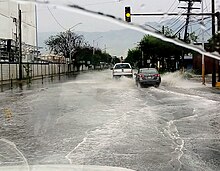Flash flood
The examples and perspective in this article may not represent a worldwide view of the subject. (October 2022) |



A flash flood is a rapid
Flash floods are a significant hazard, causing more fatalities in the U.S. in an average year than lightning,
Causes

Flash floods most often occur in dry areas that have recently received
Hazards

The United States
In deserts, flash floods can be particularly deadly for several reasons. First, storms in arid regions are infrequent, but they can deliver an enormous amount of water in a very short time. Second, these rains often fall on poorly absorbent and often clay-like soil, which greatly increases the amount of runoff that rivers and other water channels have to handle.[7] These regions tend not to have the infrastructure that wetter regions have to divert water from structures and roads, such as storm drains, culverts, and retention basins, either because of sparse population or poverty, or because residents believe the risk of flash floods is not high enough to justify the expense. In fact, in some areas, desert roads frequently cross a dry river and creek beds without bridges. From the driver's perspective, there may be clear weather, when a river unexpectedly forms ahead of or around the vehicle in a matter of seconds.[8] Finally, the lack of regular rain to clear water channels may cause flash floods in deserts to be headed by large amounts of debris, such as rocks, branches, and logs.[9]
Deep slot canyons can be especially dangerous to hikers as they may be flooded by a storm that occurs on a mesa miles away. The flood sweeps through the canyon; the canyon makes it difficult to climb up and out of the way to avoid the flood. For example, a cloudburst in southern Utah on 14 September 2015 resulted in 20 flash flood fatalities, of which seven fatalities occurred at Zion National Park when hikers were trapped by floodwaters in a slot canyon.[10]
Flash flood impacts
Flash floods induce severe impacts in both the built and the natural environment. The effects of flash floods can be catastrophic and show extensive diversity, ranging from damages in buildings and infrastructure to impacts on vegetation, human lives and livestock. The effects are particularly difficult to characterize in urban areas.[11]
Researchers have used datasets such as the Severe Hazards Analysis and Verification Experiment (SHAVE) and the U.S. National Weather Service (NWS) Storm Data datasets to connect the impact of flash floods with the physical processes involved in flash flooding. This should increase the reliability of flash flood impact forecasting models.[12] Analysis of flash floods in the United States between 2006 and 2012 shows that injuries and fatalities are most likely in small, rural catchments, that the shortest events are also the most dangerous, that the hazards are greatest after nightfall, and that a very high fraction of injuries and fatalities involve vehicles.[13]......
An impact severity scale is proposed in 2020 providing a coherent overview of the flash flood effects through the classification of impact types and severity and mapping their spatial extent in a continuous way across the floodplain. Depending on the affected elements, the flood effects are grouped into 4 categories: (i) impacts on built environment (ii) impacts on man-made mobile objects,(iii) impacts on the natural environment (including vegetation, agriculture, geomorphology, and pollution) and (iv) impacts on the human population (entrapments, injuries, fatalities). The scale was proposed as a tool on prevention planning, as the resulting maps offer insights on future impacts, highlighting the high severity areas.[11]
Flash floods can cause rapid soil erosion.
Some wetlands plants, such as certain varieties of rice, are adapted to endure flash flooding.[17] However, plants that thrive in drier areas can be harmed by flooding, as the plants can become stressed by the large amount of water.[18][19]
See also
- Coastal flood
- Drowning
- Flash Flood Guidance Systems
- Flash flood warning
- Flash flood watch
- Freshet
- Huayco
- Lifesaving
- Kalla kadal
- Storm surge
- Jökulhlaup
References
- ^ "Flash Flooding Definition". National Weather Service. Archived from the original on September 1, 2017. Retrieved August 31, 2017.
- ^ WeatherEye (2007). "Flash Flood!". Sinclair Acquisition IV, Inc. Archived from the original on 2009-02-27. Retrieved 2009-09-09.
- ^ a b National Weather Service Forecast Office Morristown, Tennessee (2006-03-07). "Definitions of flood and flash flood". National Weather Service Southern Region Headquarters. Archived from the original on 2006-09-29. Retrieved 2009-09-09.
- National Weather Service. Archived from the originalon 2008-01-11. Retrieved 2007-06-25.
- U.S. Department of Commerce, National Oceanic and Atmospheric Administration National Weather Service, Federal Emergency Management Agency, American Red Cross. July 1992. Archivedfrom the original on 2007-07-05. Retrieved 2007-06-25.
- ^ "Turn Around Don't Drown". Archived from the original on 2018-11-29. Retrieved 2007-06-25.
- .
- ISBN 0-87720-196-X. Archived from the original(PDF) on 2008-06-25. Retrieved 2008-07-17.
- ^ Jahns, R.H. (1949). "Desert floods" (PDF). Engineering and Science. 12 (8): 10–14. Archived (PDF) from the original on 30 April 2021. Retrieved 17 July 2021.
- .
- ^ S2CID 225031085.
- .
- .
- ISBN 978-0-7923-6826-7.
- .
- .
- PMID 20934370.
- PMID 21443603.
- PMID 26694376.
Further reading
- Schmittner, Karl-Erich; Pierre Giresse (August 1996). "Modelling and application of the geomorphic and environmental controls on flash flood flow". Geomorphology. 16 (4): 337–47. .
External links
- Scottish Flash Flood on YouTubePublic clip of the Fochabers flood in Moray September 9
- Decision tree to choose an uncertainty method for hydrological and hydraulic modelling, choosing an uncertainty analysis for flood modelling.
- Great footage of flash floods in the arid midwest heading down dry washes after heavy rain.
- Map of central Texas flash flood alley.
- Workshop Proceedings Flash Flood Management
- Workshop Proceedings Flash Flood Forecasting
- Hydrologic Research Center
